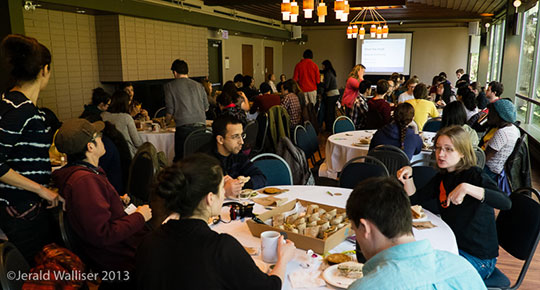
“We use it for chemicals, anything that lets off hazardous fumes, like formaldehyde or other toxic substances.”
Megan Filiatrault, Lab Manager at the Hieter Lab in the Michael Smith Laboratories, is standing in front of a fume hood, a rectangular cupboard shaped like a raised fireplace with a sliding glass front—the sash. When she lifts the sash, the gentle hum of the hood’s fan becomes a steady roar.
“The primary use of the fume hood is to protect you—and all the people in the lab—when you’re doing an experiment. You can put your arms in and do whatever you need to do with your hazardous chemicals, pipettes or other equipment. Then you’re supposed to close it, though sometimes we do forget.”
From January 28 to March 8, Campus Sustainability partnered with BC Hydro and FortisBC in Shut the Sash, the second iteration of a six-week energy-saving competition focusing on fume hoods. Laboratories consume ten times as much energy as other types of space on campus, largely because of fume hoods, andUBC has about a thousand fume hoods in various labs across campus. Shut the Sash focused on a subset of the two hundred or so Variable Air Volume (VAV) fume hoods, like the ones in Filiatrault’s labs, which control air flow based on sash position.
Research labs in three buildings—Michael Smith Laboratories, Chemistry Building (D and E Block) and Biological Sciences Building (West and South wings)—participated in the competition. Researchers—more than one hundred grad students, post-doctoral fellows and research assistants—formed teams and competed in weekly challenges against other teams in their buildings. Weekly spot checks of sash heights determined the prizewinners, culminating in $500 for first place and $250 for second place in each building.

A Big Change in Awareness
“The competition results are impressive—researchers reduced their sash heights by 82%,” says Lillian Zaremba, Climate and Energy Engineer, Campus Sustainability. “Over the two years of the competition, we estimated that the labs saved 117,000 kWh of electricity and 2,000 GJ of natural gas, and reduced GHG emissions by 105 tonnes—equivalent to 60 round-trip flights from Vancouver to St. John’s, Newfoundland.”
“There’s been a big change in awareness,” says Truman Wambach, a graduate student in Chemistry who works in D Wing of the Chemistry Building.
“More people got into their sash closing, were more aware of what was going on. I wouldn’t say they were gung-ho, but they were definitely more aware and put more effort into making sure the hoods were closed.”
Wambach adds that having someone come by once a week to check that the sashes were closed helped encourage good habits. “People knew about the issue from last year, but the competition reinforces that closing the sash saves energy—it definitely does increase awareness.”
Encouraging Good Long-Term Habits
“People in the lab knew more about it, especially the second time around,” agrees Dr Gillian Dean, Research Associate, Kunst and Haughn Labs, part of the Botany Department. “We were winners, we had a lot of stickers all over the sashes to remind us to close them, which is very nice—any time you go near the hoods you can’t help but see them. And of course we all like to win prizes!”
The stickers say “This fume hood uses three times the energy of a family home,” adds Dean. “I don’t think any of us realized they used that much energy!”
Dean thinks that the good habit will last long after the competition is over. “It’s an incredibly simple behaviour change—all you have to do is close the sash.”

Looking For New Ways to Make Labs More Sustainable
In a survey conducted at the end of the competition, an overwhelming majority of people said that they learned something during Shut the Sash and would participate in future energy conservation campaigns.
“It’s important for everyone at UBC to have a way to contribute to the university’s ambitious climate action goals,” says Zaremba. “Researchers make up a big group on campus, and this is an easy and effective way for them to save energy and reduce greenhouse gas emissions.”
“Because of the high volumes of conditioned air they consume and how intensely they are used, laboratories are a great opportunity for energy conservation,” says Orion Henderson, Director of the UBC Sustainability Office. “Our good and bad habits can have big impacts on energy consumption, as can lab design and operation. So in tandem with our behaviour pilots we are re-thinking our lab design requirements and piloting retrofit measures to improve the efficiency of lab operation.
“For example, we are looking at converting labs from constant volume HVAC control to variable volume, to reduce conditioned air consumption when high flows are not required. Our aim is to employ a comprehensive set of energy conservation measures to effectively manage energy consumption in the most energy-intense area of UBC’s operation.”
To find out more about laboratory fume hoods and Shut the Sash, including full competition results, visit the website, or email shut.the.sash@ubc.ca..
August 12, 2013